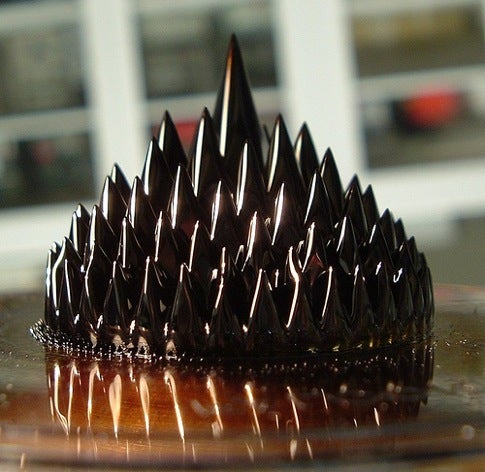How to make ferrofluid
We've found three good options for making this oily liquid.

Ferrofluids are made up of tiny magnetic fragments of iron suspended in oil (often kerosene) with a surfactant to prevent clumping (usually oleic acid). The fluid is relatively easy to make at home, yet extremely expensive to buy online. How does $165 a liter sound? Pretty bad, right? Read on to learn how to make ferrofluids on the cheap.
There are many commercial applications for ferrofluids—speakers and hard drives being the most common. The oily fluid prevents debris from entering hard drives when a small amount is placed between the magnets and shaft. In the case of speakers, ferrofluids remove heat from the voice coils and help dampen the cone movement. My own interest in the black ooze is a desire to create custom cases for electronics. And even more fun can be had making dynamic molds by pouring a hardening agent over the fluids.
If you are still wondering what ferrofluids are take a look at this video:

DIY option 1: magnetic ink developer

Using a magnetic ink developer (MICR) seems to be the easiest way to make a smooth ferrofluid at home. Simply purchase a $19 bag of developer and add some veggie oil. Using a lower-viscosity oil like kerosene or biodiesel along with a surfactant (citric acid, oleic acid, etc.) may improve the quality further.
DIY option 2: ferric chloride
The ferric chloride conversion is clever. Electronics enthusiasts often keep ferric chloride at home to eat away copper which makes a reasonable DIY circuit board. The chemistry involved seems easy enough.
- Mix ferric chloride with water.
- Add steel wool—stir until bright green.
- Use a coffee filter as a strainer.
- Add more ferric chloride.
- Add ammonia.
- Heat for a hour at boiling (in a well ventilated space).
- Let the solution cool.
- Add kerosene.
- Pour off kerosene and discard water.
DIY option 3: recycling audio cassettes
Finally, we have what looks like the most DIY approach—acetone to extract the iron particles from old cassette tapes. Obtaining tapes and using acetone is labor intensive, but commendable.
Controlling the shape of ferrofluids and then “freezing” them in place could be another tool for inexpensive desktop fabrication. Combining two unusual uses of magnetic fluids invites further empowerment for the maker. A French nail polish has magnetic particles that can be triggered into elegant patterns after being applied and before setting up. And Martin Frey has a dynamically controlled ferrofluid art piece titled SnOil that offers 144 pixels that is a low-res display.
I plan to try the chemical ferric chloride approach used in DIY option 2, substituting the kerosene for biodiesel and the oleic acid for citric acid. In order to get a freeze effect I will begin with pouring epoxy resin over the ferrofluid. Then observe the fluid’s behavior. Can it hold a shape long enough for the resin to setup? That, we shall see.